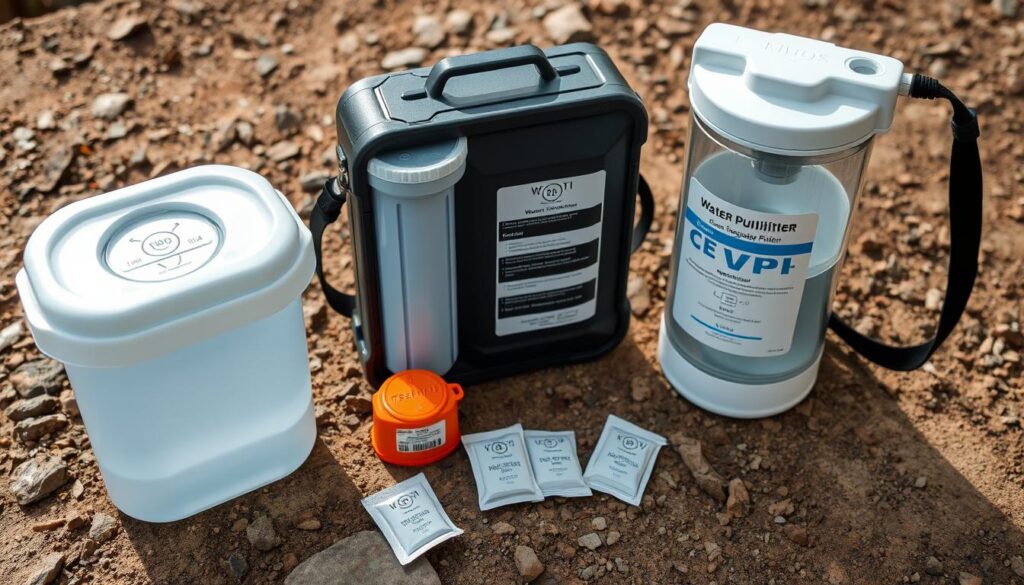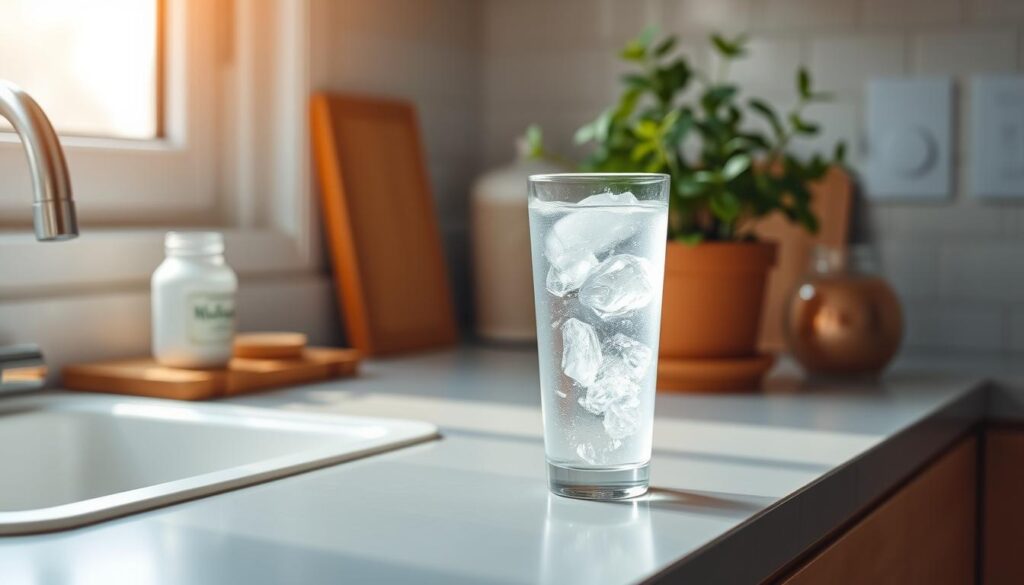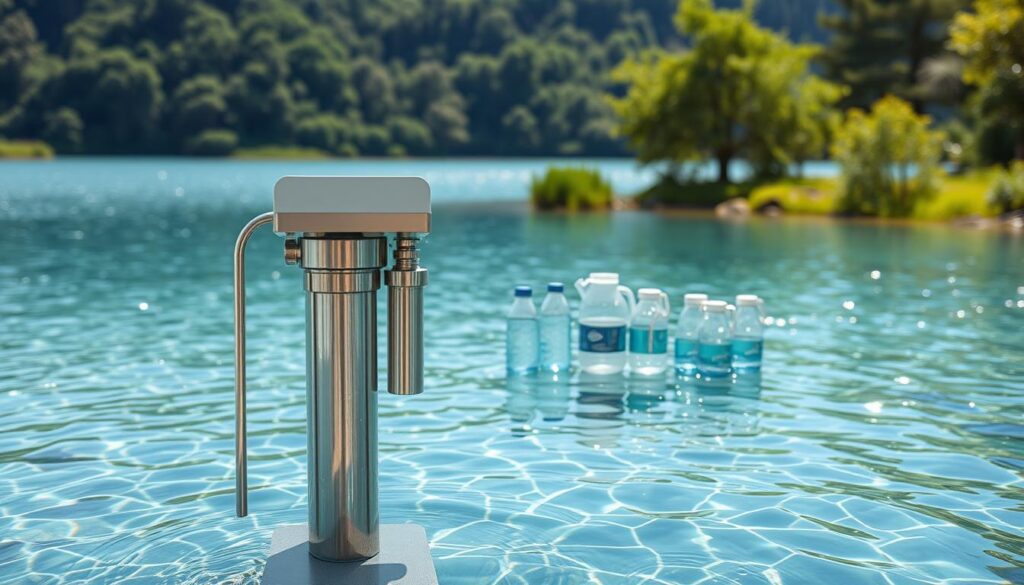Having safe drinking water is key during emergencies. I’ve learned this the hard way. It’s a lesson I’ve never forgotten. Always use bottled, boiled, or treated water for drinking, cooking, and personal hygiene to stay safe.
In this guide, I’ll show you effective methods to purify water during emergencies. This ensures you and your family stay safe. We’ll cover everything from why clean drinking water is important to how to use these methods.
Key Takeaways
- Understanding the importance of safe drinking water during emergencies
- Learning various methods for purifying water
- Implementing effective water purification techniques
- Ensuring safety for you and your family
- Having a complete guide for emergency situations
Understanding the Importance of Water Purification
Water purification is key to our health and well-being. In emergencies, clean drinking water is vital for survival. It’s not just about taste; it’s about removing harmful contaminants.
Untreated water poses serious health risks. It can contain harmful substances like bacteria and parasites. These can cause diseases such as dysentery and typhoid.
Why Clean Water Matters
Clean water is vital for drinking, cooking, and hygiene. Without it, the risk of waterborne diseases grows. Water treatment solutions make water safe for us.
Access to clean water is critical in emergencies. It can mean the difference between life and death.
Common Contaminants in Water
Knowing common water contaminants is key to purifying water. Water can have biological, chemical, and physical contaminants. Biological contaminants include harmful bacteria and viruses.
Chemical contaminants come from industrial waste and agricultural runoff. Physical contaminants can affect water taste and safety.
By understanding these contaminants, we can purify water safely. This is essential for our health, even in emergencies.
Types of Impurities in Water
Water can have many types of impurities. Each one needs a different way to be treated. Knowing about these is key for clean drinking water methods and purifying water well.
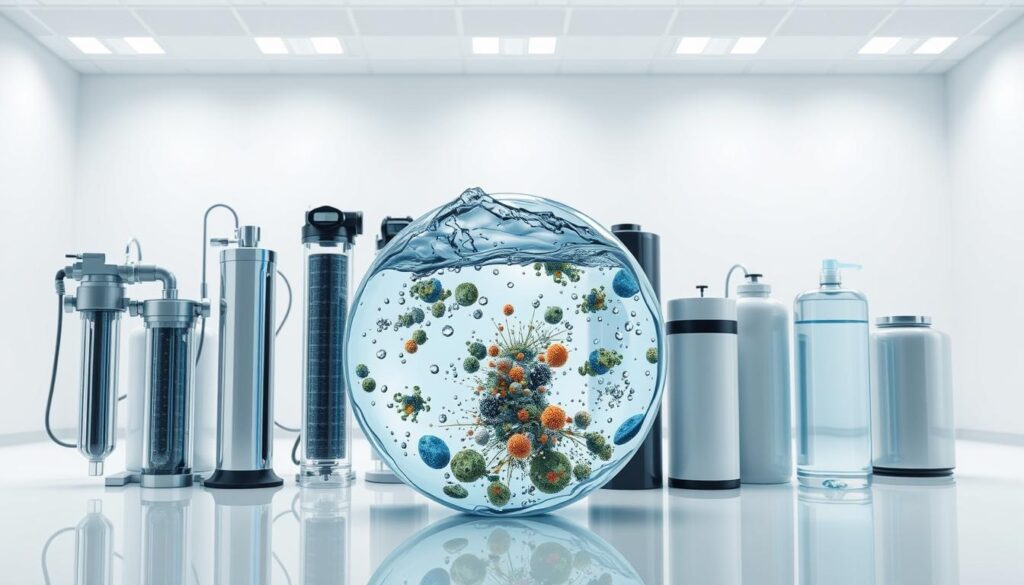
Biological Contaminants
Biological contaminants are harmful microorganisms like bacteria, viruses, and parasites. They can cause serious health problems. It’s very important to filter contaminated water to get rid of these harmful pathogens.
Some common biological contaminants include:
- Bacteria such as E. coli and Salmonella
- Viruses like Rotavirus and Norovirus
- Parasites including Giardia and Cryptosporidium
Chemical Contaminants
Chemical contaminants include heavy metals, pesticides, and industrial pollutants. These can harm health over time, even in small amounts. It’s vital to use clean drinking water methods that remove or neutralize these chemicals.
Examples of chemical contaminants are:
- Heavy metals such as lead and mercury
- Pesticides and herbicides
- Industrial chemicals like PCBs and dioxins
Physical Contaminants
Physical contaminants are things like dirt, sediment, and other particles that can change water’s look, taste, and smell. While they might not be harmful themselves, they can show that there are other, more dangerous impurities. The first step in filtering contaminated water often involves removing these physical contaminants.
Examples include:
- Suspended solids and sediments
- Particulate matter
Knowing about the different impurities in water helps people choose the right clean drinking water methods and technologies. This ensures they have access to safe, clean drinking water.
Boiling as a Purification Method
Boiling water is a simple yet effective way to kill germs and make water safe. It has been used for centuries. It’s a reliable method, even in emergency situations.
Boiling water kills bacteria, viruses, and protozoa that cause illness. When water boils, the heat denatures the proteins of these microorganisms. This effectively kills them, making the water safe to drink.
How Boiling Works
The process of boiling is straightforward. Water is heated until it reaches its boiling point, which is 212°F (100°C) at sea level. At this temperature, most pathogens are killed quickly.
It’s essential to note that boiling is effective against many contaminants. This includes Giardia and Cryptosporidium, which some chemical disinfection methods can’t handle.
Recommended Boiling Times
To properly purify water, it’s important to boil it for the right time. Guidelines say to boil water for 1 minute to kill most pathogens. But, at elevations above 6,500 feet, boil for 3 minutes. This is because the boiling point is lower at higher altitudes.
For more information on boiling as a purification method, visit this resource. It offers insights into boiling’s effectiveness in various situations.
Chemical Purification Methods
In some cases, boiling water isn’t possible. Chemical disinfection is a good alternative. It uses disinfectants to kill harmful microorganisms in water.
Learning how to use chemical disinfection is key for being ready for emergencies. You can use household bleach or iodine tablets. Both methods are effective but need to be handled carefully.
Using Household Bleach
Household bleach is a common and effective way to purify water. It’s important to know how much to use and for how long. Use unscented bleach with 5.25% to 8.25% sodium hypochlorite concentration.
- For clear water, add 1-2 drops (about 0.1 mL) of bleach per liter or quart of water.
- For cloudy or cold water, double the dose to 2-4 drops.
- Stir well and let it stand for at least 30 minutes before drinking.
Following these steps ensures the water is safe to drink without too much chlorine.
Iodine Tablets and Their Effectiveness
Iodine tablets are also good for disinfecting water. They are easy to use and require minimal equipment. Iodine tablets come in measured doses, making it easy to get the right amount.
To use iodine tablets effectively:
- Follow the manufacturer’s instructions for the correct dosage.
- Typically, one tablet is added to a liter of water.
- Allow the tablet to dissolve and the water to stand for the recommended time, usually 30 minutes.

Both bleach and iodine tablets can effectively disinfect water in emergencies. It’s important to know the right amount and time to ensure the water is safe.
Filtration Techniques
Effective water filtration strategies can save lives in emergencies. When faced with contaminated water, the right methods can lower illness risks. Knowing the different filtration techniques is key for making good water purification choices.
Types of Filters
There are many filters for purifying water, like ceramic, carbon block, and membrane filters. Ceramic filters remove bacteria, viruses, and parasites, making them great for emergencies. Carbon block filters get rid of chemicals and improve water taste and smell.
Choosing the right filter depends on the water’s contaminants and the filter’s capabilities. Some filters target specific contaminants, so knowing your water’s condition is important.
DIY Water Filtration Systems
DIY water filtration systems are also a good, affordable option. Using sand, charcoal, and gravel can filter out many contaminants. This method, though not as strong as commercial filters, can make water safer.
To make a basic DIY system, layer sand, charcoal, and gravel in a container. Each layer helps remove different contaminants. While it takes some trial and error, it’s a useful skill for emergencies.
By learning and using these filtration methods, people can get safer drinking water in emergencies.
Solar Water Disinfection
Purifying water in the wild can be simple with the sun’s power. Solar water disinfection, or SODIS, uses sunlight to kill harmful germs in water. This makes the water safe to drink.
The SODIS Method Explained
To use SODIS, fill a clear plastic bottle with water and leave it in direct sunlight for at least six hours. The UV rays from the sun kill bacteria and viruses. For better results, place the bottle on a reflective surface like aluminum foil or a metal roof.
- Use clear plastic bottles; colored or tinted bottles don’t work.
- Fill the bottle with water, leaving some space at the top.
- Place the bottle on a reflective surface in direct sunlight.
- Leave it exposed for at least six hours or overnight if possible.
Benefits of Solar Purification
Solar water disinfection has many benefits. It’s a great way to purify water in the wild. Here are some key advantages:
| Benefit | Description |
|---|---|
| Cost-Effective | SODIS is cheap because it uses sunlight. You don’t need expensive equipment or chemicals. |
| Environmentally Friendly | This method is good for the environment. It doesn’t produce harmful waste or by-products. |
| Easy to Implement | SODIS is simple. It requires little equipment and knowledge, making it easy for anyone to use. |
For more info on water purification methods, including home use, check out my guide on mastering purification methods at home.
Using Activated Charcoal
Activated charcoal is a simple yet effective way to purify water. It can remove chemicals and improve water taste. This makes it a great tool for emergency water purification.
How Activated Charcoal Works
Activated charcoal attracts and holds onto chemicals and impurities in water. This is called adsorption. It’s different from absorption, where a substance is soaked up like a sponge.
Adsorption happens when molecules stick to the charcoal’s surface. This is why it’s good at removing chlorine, VOCs, and other chemicals. These substances can change water’s taste and smell.
The effectiveness of activated charcoal comes from its highly porous structure. This structure offers a large surface area for adsorption. When water flows through a filter with activated charcoal, impurities get trapped. This leaves you with cleaner, better-tasting water.
“Activated carbon is effective in removing a wide range of contaminants, including chlorine, taste, and odor-causing compounds.”
Making Your Own Charcoal Filter
Making your own charcoal filter is easy with a few materials. You’ll need activated charcoal, a container (like a plastic bottle), sand, and gravel.
- Start by cutting the bottom off the plastic bottle to create a funnel.
- Layer gravel at the bottom, followed by a layer of sand.
- Add a layer of activated charcoal on top of the sand.
- Then, add another layer of sand.
As water flows through, the charcoal adsorbs impurities. This improves the water’s quality. This DIY method is affordable and practical for purifying water in emergencies.
Capturing Rainwater
Capturing rainwater is a smart way to add to your emergency water supply. It involves collecting and storing rainwater for later use. This gives you a clean water source when you need it most.
Safely Collecting Rainwater
To collect rainwater safely, use a clean system. This means a roof catchment area and a downspout or gutter system. Make sure the roof is free from contaminants like heavy metals or pesticides.
The storage container should be strong and safe for food. It must be resistant to corrosion and sealed well to keep out mosquitoes and other contaminants. Check the container often for any damage.
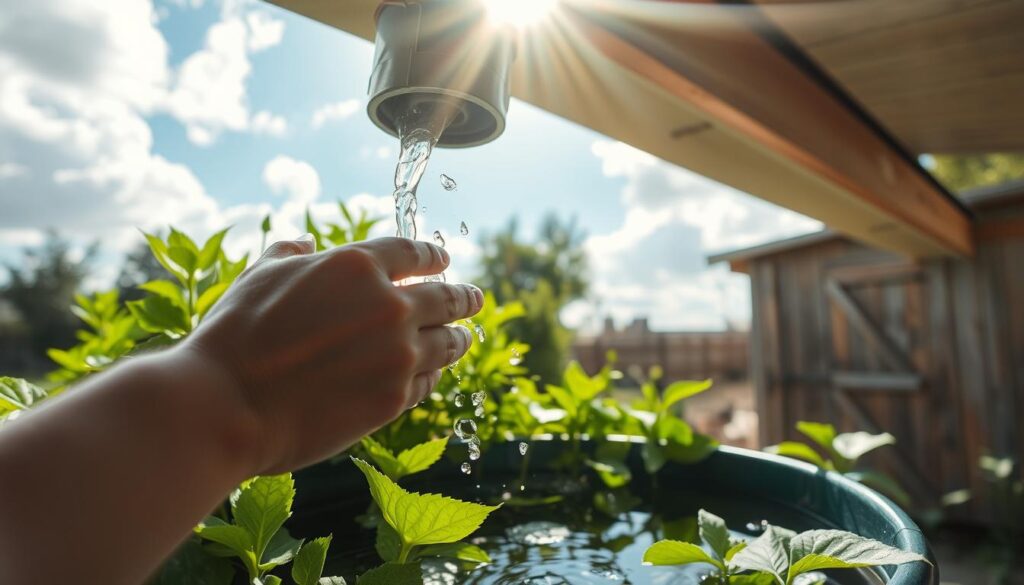
Purification Steps After Collection
After collecting rainwater, purify it before drinking. Boiling is a top choice because it kills off harmful germs. You can also use water purification tablets or filters to clean the water.
If you like natural methods, try SODIS (Solar Disinfection). Place the rainwater in clear plastic bottles and leave them in the sun for at least six hours. The UV rays will kill the germs.
- Boiling: Bring the water to a rolling boil for 1-3 minutes.
- Chemical Disinfection: Use purification tablets or bleach according to the manufacturer’s instructions.
- Filtration: Pass the water through a filter designed for removing bacteria and viruses.
Portable Water Purifiers
Portable water purifiers have changed how we get clean drinking water in many situations.
These devices are small, light, and work well. They’re great for outdoor fun, emergencies, or when traveling to places with bad water.
Popular Brands and Their Features
Many brands are known for their portable water purifiers. They offer different features for various needs.
- LifeStraw: LifeStraw is simple and effective. It has many products with advanced filters.
- Sawyer Products: Sawyer Mini and other Sawyer products filter out many contaminants. This includes bacteria, viruses, and particles.
- MSR: MSR’s purifiers are for outdoor lovers. They are reliable and easy to use in different places.
Best Practices for Use
To use a portable water purifier well, follow some key steps.
- Read the Manual: Learn how to use, maintain, and fix the device from the maker’s guide.
- Regular Maintenance: Clean and care for the device as suggested. This keeps it working well for a long time.
- Pre-Filtering: If you can, filter or settle the water first. This helps the purifier last longer.
| Brand | Filter Life | Flow Rate | Weight |
|---|---|---|---|
| LifeStraw Personal | 1,000 Liters | 1.7 Liters/Minute | 57g |
| Sawyer Mini | 100,000 Gallons | 1 Liter/Minute | 2 oz (57g) |
| MSR TrailShot | 1000+ Liters | 2.5 Liters/Minute | 11.5 oz (326g) |
Emergency Water Storage Tips
Having a good plan for storing water is key to being ready for emergencies. It makes sure you have clean drinking water when you need it.
Recommended Containers
Choosing the right container for water storage is important. I suggest using food-grade plastic containers or stainless steel tanks made for water. They should be clean, strong, and not have chemicals that can harm the water.
Make sure the containers are tightly closed to keep out contaminants. I like containers with spigots for easy water access, which helps avoid spills and contamination.
Storage Location and Conditions
Where you store your emergency water is as important as the containers. Store it in a cool, dark place, away from sunlight and things that could contaminate it, like chemicals or fuel.
The storage area should be dry and well-ventilated to avoid moisture. This can cause mold or bacteria. Also, keep the containers off the ground to protect them from flooding or pests.
By following these tips, you can have a steady supply of clean drinking water during emergencies.
Maintaining Water Quality Over Time
To keep water safe to drink, we must focus on maintaining its quality. This means stopping contamination and testing the water often.
Strategies for Prevention
Stopping contamination is key to keeping water quality up. Store water in clean, food-grade containers. Keep them away from harmful chemicals and waste.
Regular Testing is Essential
Testing stored water regularly is very important. Look for signs of contamination like odd smells, colors, or sediment. Boiling or filtering water can also help keep it clean.
By following these steps, we can keep our water safe for drinking. This is important in emergency situations.
FAQ
What are the most effective emergency water purification methods?
Effective methods include boiling, using household bleach or iodine tablets, and filtration. Solar water disinfection and activated charcoal are also good options.
How long should I boil water to make it safe to drink?
Boil water for at least one minute to kill most germs. At high elevations, boil for three minutes.
Can I use household bleach to purify water, and if so, how?
Yes, you can use bleach. Add 1/8 teaspoon or 8 drops per gallon. Mix well and let it sit for 30 minutes before drinking.
What is the SODIS method, and how does it work?
SODIS uses sunlight to purify water. Fill clear bottles with water and leave them in the sun for six hours. UV rays kill bacteria, making the water safe.
How can I make my own charcoal filter for water purification?
Make a filter with activated charcoal, sand, and gravel. Layer these in a container. Water flows through, filtering it.
What are the best practices for storing emergency water?
Store water in clean, airtight, food-grade containers. Keep them cool, dry, and away from contaminants.
How often should I test stored water for quality?
Test stored water every six months. Check for contaminants and the condition of containers.
Can portable water purifiers effectively remove all contaminants from water?
Portable purifiers remove many contaminants. But, effectiveness depends on the brand and maintenance. Always follow the manufacturer’s guidelines.
Is rainwater safe to drink after collection?
Rainwater can be contaminated. Purify it before drinking using boiling, filtration, or chemical disinfection.
What are some common mistakes to avoid when purifying water in emergency situations?
Avoid not following purification guidelines and using dirty equipment. Regularly test water quality and store it properly to prevent contamination.

